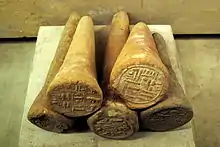Funerary cone
Funerary cones were small cones made from clay that were used in ancient Egypt, almost exclusively in the Theban Necropolis.[1] The items were placed over the entrance of the chapel of a tomb. Early examples have been found from the Eleventh Dynasty. However, they are generally undecorated. During the New Kingdom, the cones were smaller in size and inscribed in hieroglyphs with the title and name of the tomb owner, often with a short prayer. The exact purpose of the cones is unknown, but hypotheses exist that they variously served as passports, architectural features, and symbolic offerings, among others.[2][3]

Funerary cones were first organized into a corpus by Davies and Macadam (1957).[4] This catalog was later supplemented by Vivo and Costa (1997).[5] In the 21st century, Dibley and Lipkin (2009) and Zenihiro (2009) have compiled more complete publications, with Theis (2017) contributing additional cones from books, articles, auction and exhibition catalogues for consideration.[6]
See also
- Chamber tomb
- Clay nail–(Mesopotamia)
References
- "Geographical distribution". Retrieved 2009-06-15.
- "Funerary Cones of the 18th Dynasty (from Thebes)". Retrieved 2008-04-20.
- "The World of Funerary Cones - Functions". sites.google.com. Retrieved 2019-02-20.
- Davies, N. de G. and M.F.L. Macadam (1957), A corpus of inscribed Egyptian funerary cones. Griffith Institute, Oxford.
- Vivó, Jaume. "Funerary Cones Unattested in the Corpus of Davies and Macadam (Annex 1)". Cite journal requires
|journal=(help) - Theis, Christoffer. "Funerary Cones from various Auctions and Collections". PalArch's Journal of Archaeology of Egypt/ Egyptology 14 (2017), Pp. 1–25.
Further reading
- Zenihiro, Kento (2009). The Complete Funerary Cones. Self-published. ISBN 978-4-89630-246-2.